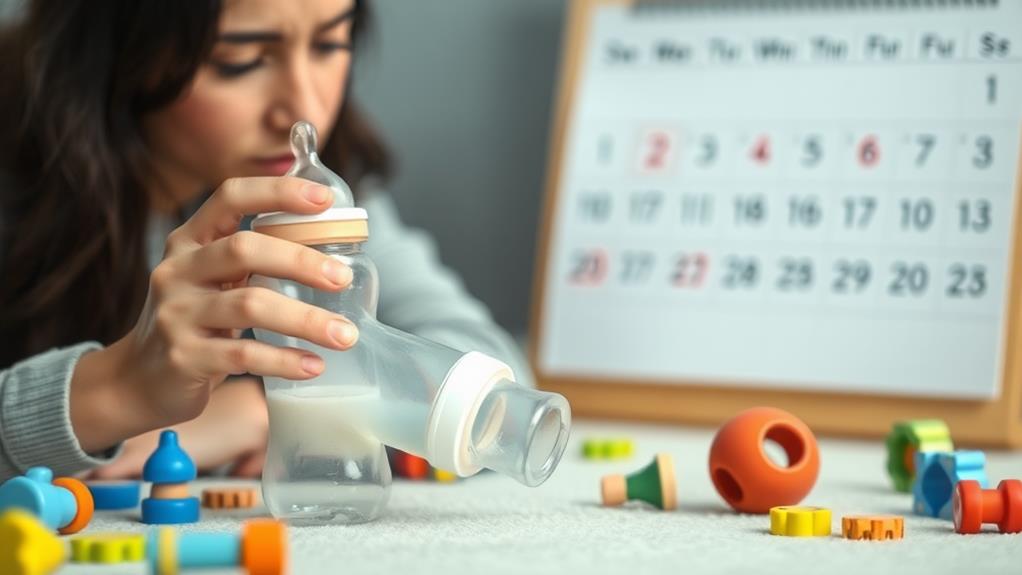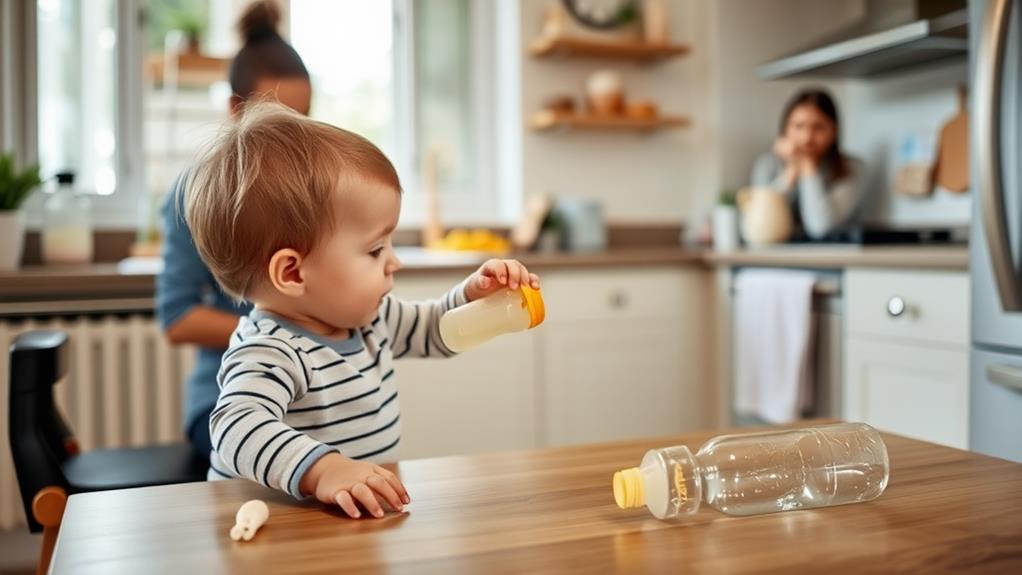Deciding when to stop baby bottle feeding can be challenging, and it's often a delicate balance between your child's needs and developmental milestones. Ideally, you should aim for a transition between 12 to 24 months, but recognizing the right time and method can make all the difference. As you navigate this period, there are various strategies you can employ to ensure a smoother weaning process. Understanding common challenges and knowing what signs to look for in your child will be crucial. So, what are the key factors to consider for a successful transition?
Health Risks of Prolonged Bottle Use

Prolonged bottle use can pose significant health risks for your child. You might think that a bottle is just a simple way to keep your little one happy, but it can lead to some serious issues.
For starters, drinking sugary liquids from a bottle can cause tooth decay, leading to early childhood caries. If your child continues using a bottle past age 2, they're at a higher risk of obesity by age 6, thanks to those extra calories from bottle sipping.
But that's not all! Constant reliance on a bottle can also contribute to developmental delays, especially in the muscles needed for clear speech.
Plus, if your child is drinking from a bottle while lying down, they might be more likely to develop ear infections, as this can promote bacterial growth in the mouth and throat.
And let's not forget about the impact on their teeth; prolonged bottle use can misalign adult teeth and affect facial muscle development.
Ideal Timing for Transition
Recognizing the health risks associated with prolonged bottle use, it's important to consider the right timing for moving to a cup. The ideal age range for this transition is between 12 to 24 months.
You'll notice your little one displaying signs of readiness for cup use around 6 months, especially when they start munching on solid food. That's when pediatricians suggest introducing a cup to help ease the shift.
Most kids can master cup coordination by 12 months, making it a perfect time to start weaning off the bottle. The American Academy of Pediatrics actually recommends that you aim for complete weaning by 18 months. This helps reduce health risks, such as tooth decay and improper nutrition.
To make this transition smooth, try gradually eliminating one bottle feeding at a time, especially before mealtime. It's like teaching your child a new skill, and with your guidance, they'll be sipping from a cup in no time!
Strategies for Smooth Weaning

As you begin the weaning process, it's essential to have a clear strategy in place to make the transition from bottle to cup easier for both you and your child.
Start by introducing cups around six months old. This helps your baby associate drinking with mealtimes, which is a great first step.
Next, gradually replace one bottle feeding at a time, beginning with daytime bottles. Save the nighttime bottle for last since it often brings comfort.
You can also use positive reinforcement—praise your baby when they drink from a cup! Celebrate those milestones.
Consistency is key, so maintain a routine during mealtimes and bedtime. This reinforces the habit of drinking from a cup instead of a bottle.
Watch for signs of resistance; if your baby pushes back, adapt your strategies. Don't hesitate to consult your pediatrician if you run into challenges. They can offer additional support and guidance tailored to your baby's needs.
Choosing the Right Cup
Choosing the right cup for your little one can make all the difference in their transition from bottle to cup. You might want to start with sippy cups that have hard spouts or straws. These options can help promote oral muscle development and better drinking skills.
Look for cups with easy-to-hold handles and simple designs that encourage independent drinking. You know how toddlers love to explore, right?
While spill-proof valves might seem handy, they can actually hinder proper drinking techniques. Instead, consider open cups or transition cups. Exploring different styles will help you find the one that fits your child's preferences.
Plus, cups with weighted bottoms are a great idea! They help minimize spills when tipped, making self-feeding less messy and more fun.
Common Challenges During Weaning

What challenges might you face when weaning your child off the bottle? First off, it's totally normal for your child to resist this change. You might see some tears or even tantrums as they feel frustrated about losing their familiar bottles. It can be tough!
Some kids might even refuse to drink enough water at first, which can lead to dehydration. So, keep an eye on their fluid intake during this transition.
Another challenge is the emotional attachment many children have to their bottles. This can lead to power struggles, but remember, patience and understanding are key.
It's also common for sleep disturbances to happen, especially if your child is used to having a bottle at bedtime. Establishing a comforting bedtime routine can really help.
To make weaning easier, try to encourage your child with distractions. Cuddles and their favorite toys can provide comfort when they're feeling upset.
Just keep things light and fun! With a little time and support, your child will adapt to this new phase, and you'll both feel proud of the progress you've made together.
Monitoring Your Child's Progress
Monitoring your child's progress during the weaning process is crucial for ensuring a smooth transition away from bottle feeding. Keep an eye on how much milk your child drinks from a cup. You want to make sure they're staying hydrated while relying less on bottles.
Look for signs that show they're ready for this change, like showing interest in cups or trying to manipulate objects. These signs can help you gauge their progress.
Be aware of any resistance or power struggles regarding the bottle. If you notice major challenges, don't hesitate to consult a pediatrician for guidance.
Celebrating milestones can make this journey more enjoyable, too! Every time your child drinks from a cup, give them a high five or a cheer. This positive reinforcement can really encourage them to keep going.
Also, watch for changes in their eating habits. As they wean off the bottle, you should see an increased interest in solid foods instead of depending on liquid calories.
Expert Tips and Resources

As your child makes strides in using cups, incorporating expert tips and resources can further support this journey. The American Academy of Pediatrics (AAP) suggests transitioning from bottles by 12 months and completing weaning by 15-18 months to help prevent issues like tooth decay.
Start gradually by replacing one bottle feeding at a time—maybe ditch the morning bottle first. This approach eases the transition, making it smoother for your little one.
Around 6-9 months, introduce different cup types, including sippy cups, straw cups, and open cups. This variety helps your child find a preferred option that promotes independence and motor skills.
And hey, don't forget the power of positive reinforcement! Celebrate small victories in cup usage, turning weaning into a fun adventure for both of you.
If you're ever unsure, consulting your pediatrician can provide personalized guidance. They can help tackle any challenges and ensure your child gets the right nutrition and hydration during this exciting phase.


